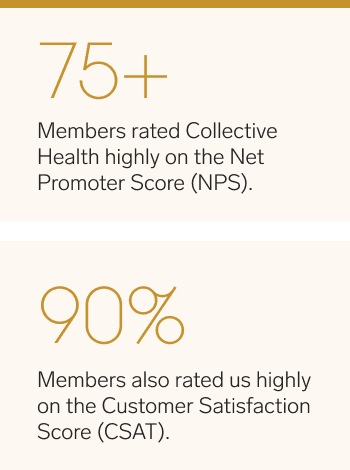Illness-related productivity losses cost US employers hundreds of billions every year, but health benefits can help you tackle the problem. Here’s what you need to know to deploy a productivity-enhancing program that focuses on your members’ health and wellbeing.
If your company has 100 employees, three are not at work today according to Bureau of Labor Statistics (BLS) numbers. A company with 500 workers may have 15 or more employees not working at any time. Illness or injury-related absenteeism makes up the lion’s share of these numbers at 72%.
We don’t need government data to know the effects of absenteeism. We’ve all lived those effects, taking on additional work to cover the gap, sometimes at the expense of other goals.
Health benefits and how well those benefits provide care can play a role, with full-featured health plans helping to reduce productivity lost to illness. Companies that don’t offer health benefits or that offer a streamlined version that employees are reluctant to access may be trading benefits-related cost savings for a different expense that’s more difficult to measure.

In business, there are few things more frustrating than a cost you can’t quite pin down, almost like piloting a boat that’s seeping water slowly from a hidden leak. You can bail out the water and stay afloat, but it will take you much longer to reach your destination.
Absenteeism has a significant and measurable cost. But like the source of the boat leak, some parts of that cost aren’t always easy to identify. Sick pay is the easy part to calculate. However, lost productivity as a whole and the related costs as other workers fill the work gap can be more difficult to calculate, especially when a portion of your workforce is pulling double duty and everyone is too busy to run the numbers.
If workers helping to fill the gap miss goals of their own, how do you begin to measure the true cost of workforce absences?
Presenteeism, Absenteeism’s Silent Partner
Perhaps more costly than absenteeism, presenteeism refers to workers who are ill or suffer from conditions that can affect focus on the job. And presenteeism isn’t always obvious.As you’d expect, presenteeism often leads to lower productivity, paired with the possibility of passing contagious illnesses on to other workers, toppling the first domino in what could be a long chain of missed business goals.
As you’d expect, presenteeism often leads to lower productivity, paired with the possibility of passing contagious illnesses on to other workers, toppling the first domino in what could be a long chain of missed business goals. The causes of presenteeism range from concerns over lost pay to concerns over access to healthcare to chronic conditions.
In many cases, employees choose to tough it out rather than risk lost pay. In other situations, the absence of healthcare benefits or a plan that feels confusing or inaccessible to members can contribute to workers choosing to go to work rather than seek medical care. Sometimes, workers choose to go to work when ill because they face their own productivity goals or milestones. Each workplace has its own culture, but some may not be as forgiving of worker absence as others.

Many of us have worked in an environment where absence due to illness wasn’t accepted as well as we might have hoped. Workers who’ve worked in less-than-ideal situations before may be more reluctant to stay home when ill. Perceived workplace culture plays a big role in presenteeism, but better communication can help resolve misconceptions and erase stigmas from previous experiences.
As importantly, it’s essential that healthcare plan members understand their benefits. Companies have the right goals but often miss the target. While 65% of companies see better benefits communication as a priority, about half of plan members don’t understand their benefits, and about 80% never open their plan materials, suggesting the number who don’t understand their benefits may be even higher than half.
And with a comprehensive healthcare benefits offering, an illness that could drain productivity for weeks through presenteeism can often be remedied in days rather than affecting productivity indefinitely. As an example, debilitating cold or flu symptoms may be the result of treatable allergies rather than a pathogen. Up to 50 million people struggle with allergies, making allergies one of the leading chronic illnesses in the US, and one of the leading drains on productivity. However, accessible healthcare benefits can bring valued team members back to full health and productivity quickly in many cases.
Download this report now
Presenteeism and chronic illness
Many studies on presenteeism focus on workers who suffer from chronic disease, and with good reason. About 6 in 10 adults in the U.S. have a chronic disease and have a chronic disease and 4 in 10 have two or more chronic ailments. That’s most of the workforce!
Among these chronic diseases are conditions like heart disease, cancer, and diabetes. Millions of workers go to work each day struggling through fatigue and other symptoms from these and other illnesses that can affect their productivity as well as their sense of contribution to the team.
A full-featured healthcare plan can help. But it’s also essential to communicate the benefits well so that members understand their options. Preventative care also plays a big role. Two-thirds of all adults want to see more emphasis on chronic disease preventive care. Much of your workforce probably share this position, even if not vocal about their priorities.
While we have more medical care choices now for chronic disease treatments, risk reduction and preventative care choices should remain a primary focus. With up to 60% of the workforce affected by chronic disease, well-designed healthcare plan features become an intrinsic part of business growth strategy rather than just a talking point to attract and retain workers.
Boost productivity with health and wellness options
In business, everything has a cost, including many cost-saving decisions. But the full cost of cost-saving decisions may not always be obvious. If you’re in HR or run a P&L for your business unit, you probably know many of the expense numbers by memory, such as other employee benefits as a percentage of payroll.
Some numbers can be more challenging to discover, however. For example, employers spend an additional $0.61 for every dollar spent on healthcare benefits. In the same study linked above, the Integrated Benefits Institute measured the annual cost of illness-related productivity losses at $575 billion. Where does this money go? You probably won’t find it on the P&L statement.

Illness-related absence and disability are both primary costs in the 61-cent figure mentioned earlier, combined with a corresponding decrease in productivity. But a well-designed wellness program paired with an easy-to-access healthcare offering can reduce some of these hidden health-related costs while also boosting productivity levels.
A healthcare and wellness benefits program has a cost, but with the data at hand, the cost is better described as an investment in worker productivity and talent retention. And with a cost-friendly structure like those found with self-funded healthcare plans, the cost of your company’s investment in healthcare and wellness benefits can be significantly lower than with traditional health insurance plans.
Healthier Employees Stay Longer
A study by Towers Watson and the National Business Group on Health points to the benefits of optimized wellness programs and their relationship to employee turnover. In the study, as reported by the Harvard Business Review, voluntary attrition for companies with a focus on effective wellness programs was nearly halved when compared to companies with less effective wellness programs (9% compared to 15%).
Wellness programs also affect employees’ decisions to join a company — or to leave one. 56% of workers with healthcare benefits stated whether they liked their benefits played a key role in their decision to leave the company or stay at their current job. Nearly half of all workers surveyed stated that healthcare plans were among their deciding factors when choosing a new employer.
The hiring landscape is more competitive than ever, but a strong wellness program combined with accessible (and understandable) healthcare benefits can help attract and retain talent.
Wellness Fosters Better Overall Job Performance
Numbers tell a story but often omit some key details that can affect progress toward business goals. Productivity losses due to absenteeism and presenteeism are a massive hidden cost to businesses, adding as much as 60% to the cost of healthcare benefits.
A healthcare plan focused on wellness and preventative care but which also makes benefits both accessible and easy to understand fosters better overall job performance. Simply put, employees who feel well work well. And when your employees feel supported, they are more inclined to want to stay and help grow your company.



